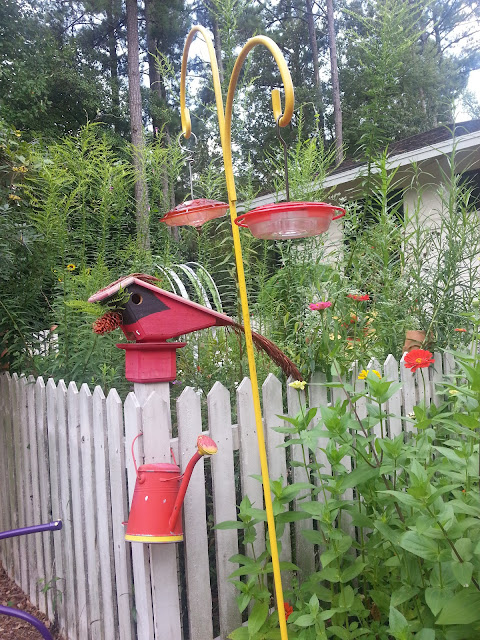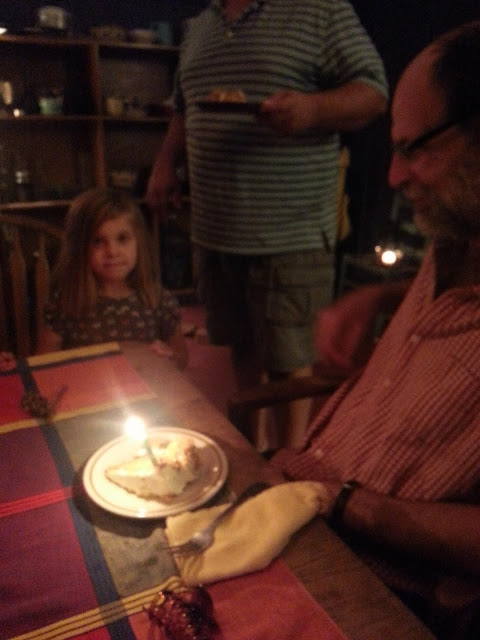new posts in all blogs
Viewing: Blog Posts Tagged with: HOME, Most Recent at Top [Help]
Results 1 - 25 of 381
How to use this Page
You are viewing the most recent posts tagged with the words: HOME in the JacketFlap blog reader. What is a tag? Think of a tag as a keyword or category label. Tags can both help you find posts on JacketFlap.com as well as provide an easy way for you to "remember" and classify posts for later recall. Try adding a tag yourself by clicking "Add a tag" below a post's header. Scroll down through the list of Recent Posts in the left column and click on a post title that sounds interesting. You can view all posts from a specific blog by clicking the Blog name in the right column, or you can click a 'More Posts from this Blog' link in any individual post.
Last semester, in my classroom at Penn, we focused on home—how the stories of our lives (and how we tell those stories) ultimately tangle with this construct.
As part of the
Beltran Family Teaching Award program, I invited my current and past students to write of home for a special publication my husband and I designed. When Anthony Ciacci, a student from a previous year, responded with his essay, I was thrilled—loved the piece so much that I whispered its existence into the ear of Trey Popp, a
Pennsylvania Gazette editor and friend. (Trey kindly visits my class each year to talk about editing and publishing, and I've been blessed to find my students' work appear in the
Gazette pages, including
these pieces.)
The rest, as they say, is history. This week, in the ever-gorgeous
Pennsylvania Gazette, Anthony's piece, modified slightly for print, appears with its own lovely illustration and shine (read the full story
here). I could not be more proud—nor more happy. Anthony is a big-souled guy, an extraordinary brother, a faithful son, and a talent. We need hearts like his at this time.
Congratulations, Anthony.
Everyone needs services of a plumber at some point in a lifetime. Although finding a qualified plumber can often sound hard and complicated, it usually doesn’t have to be like that. You can follow some rules, or better to say some logical guidelines; and doing this you will discover that finding expert isn’t such a rocket science after all.
Firstly, an experienced plumber will have the correct certification, license, and insurance policy. Certifications are some kind of evidence that the chosen plumber has the right skills for the job. And, an insurance coverage is essential because it gives some kind of safety to the clients due to the fact that they are protected if something goes wrong during the service.
It is vital that you have an effective communication when you are dealing with a plumbing company. Experienced plumbers from San Diego plumbing can provide you with clear information regarding your question, and they do it as fast as it is possible. Fast response is essential in this type of a job, especially if you are facing witn an emergency situation. Plumbers who do not have so much experience oftenly will not give you so fast solution.
 It would be good if some of your friends or relatives can recommend you some plumber company that they had used in the past. Also, they can tell you with which company they are satisfied and with which that is not the case. But, you can do the research on your own as well. Because there are many plumbing companies, you will have to do a little bit more research to find a company that provides you with the best plumbing. So, the usual glance at company’s contact information will not be enough. It would be the best to look at the company’s official website and read through customer testimonials. In that way, you can get some information from first hand.
It would be good if some of your friends or relatives can recommend you some plumber company that they had used in the past. Also, they can tell you with which company they are satisfied and with which that is not the case. But, you can do the research on your own as well. Because there are many plumbing companies, you will have to do a little bit more research to find a company that provides you with the best plumbing. So, the usual glance at company’s contact information will not be enough. It would be the best to look at the company’s official website and read through customer testimonials. In that way, you can get some information from first hand.
Nowadays, life is imaginable without usage of hot water. So, having this in mind, there is no place to wonder about the importance of a water heaters in everyday life. A water heater installation requires quality plumbing and electrical work. Due to the fact that this kind of job is more demanding in comparison to usual ones, it is of a pure essence to hire experts. For completing this task, it is very important to find professionals who have knowledge, experience and needed skills as well. Firstly, an installation methods are planned on the paper by experts. This procedure helps in making a list of needed materials, and other objects which are required during the installation. Also, technicians are always there to see the space and consider if that space is ideal for the installation or not. And, they check other connections such as water lines, valves, and other. This procedure helps in preventing any possible problem that could come up sometime in the future.

Besides proper installation, attention should be paid on a maintenance aspects as well. Regular maintenance helps in avoiding certain problems, and it also helps in reducing any damage before it gets bigger and maybe unreparable.
No matter how much you cherish your home there is a time when you need to travel. The following items will make packing and raveling simpler for you.
Space saver travel bags
Space saver travel bags are special bags that compress items to third of original size. It requires filing of the bag leaving around 4 inches between zip lock closure and the items. After packing reverse this air using your vacuum by aligning vacuum hose with one way valve of the bag. Let the vacuum run until the items placed inside compress to 1/3 of original size.
 Space saver bags are great solution to store seasonal items such as coats and sweaters. They are also great storage for bulky items like comforters, blankets and outdoor items such as patio cushions or sleeping bags. There is wide variety of sizes and shapes for space bags therefore you have unlimited organizational options. You can therefore choose space saver bags in sizes that fit well on all sorts of spaces including shelves, your closet or under the bed.
Space saver bags are great solution to store seasonal items such as coats and sweaters. They are also great storage for bulky items like comforters, blankets and outdoor items such as patio cushions or sleeping bags. There is wide variety of sizes and shapes for space bags therefore you have unlimited organizational options. You can therefore choose space saver bags in sizes that fit well on all sorts of spaces including shelves, your closet or under the bed.
Additional benefit of space bags is that they are designed to be reused hence you can use them for home storage.
Carry a portable humidifier with you
When you think about a humidifier, what comes to mind is the fairly large device that is filled with water which is plugged and kept at the corner. The traditional options will not favorable if you usually move around and it requires some effort for cleaning. Now there is solution in form of portable humidifier. This is a device that will attach to any bottle of water and draws power from USB port of a charger. A compact tabletop portable humidifier is enough for humidifying a single room and other smaller spaces. There are also larger sized humidifiers to humidify larger areas.
The Satechi USB Portable Humidifier provides a soothing environment at home, the office or traveling. To use, fill a bottle with purified water, place the humidifier into the opening, making sure the filter is submerged in water, & plug the humidifier into a USB port for instant comfort.
Tsa locks
 TSA locks can be used to secure your items in case as an ordinary padlock. It has a 3 digit code which you set and secure your case by placing 2 zip pulls into this lock. It however plays greater role when you are travelling through airports in countries like USA. It is designed with a lock that can only be opened by a master key in the possession on TSA (Transport Security Administration) officials so that they can check the secured bag and then lock it. Other keys cannot open this lock.
TSA locks can be used to secure your items in case as an ordinary padlock. It has a 3 digit code which you set and secure your case by placing 2 zip pulls into this lock. It however plays greater role when you are travelling through airports in countries like USA. It is designed with a lock that can only be opened by a master key in the possession on TSA (Transport Security Administration) officials so that they can check the secured bag and then lock it. Other keys cannot open this lock.
A TSA lock is better than padlock or other lock when on transit because TSA officials will have no option but to destroy these locks in order to open cases. It means thereafter, you case will not have secure lock.
Carry the multi-purpose Paracord bracelets
People wear bracelets to look better but paracord bracelets are different. A paracord product is destined to be a survival aid. Paracord bracelets serve many purposes. You can use them as boot laces, suspenders and belts. A tattered bracelet can serve you as replacement can also be tied on the hand or leg to stop bleeding.

Last week my husband took the boys to the Mountain West Basketball Tournament, giving me four days with the house to myself. I planned to use the time as a stay-at-home writing retreat, just Boo and me and fiendish typing.
It was spectacular.
I decided I needed to be prepared but open when it came to this writing time. While I hoped my Klondike manuscript would be back in my possession, I couldn’t plan on that happening (It wasn’t. I worked on it anyway and am thrilled with what I’ve accomplished). My goal was to have a sense of how I wanted to use the four days, but not be so rigid that I missed a creative opportunity. I ended up splitting the time between two projects, one in its very beginnings and the other nearing its end.
I planned ahead about regular commitments and how I’d handle them. For example, I got up at roughly the same time I would have had my family been home. I kept my Thursday running date and attended church on Sunday. But I made room for flexibility, skipping the gym on Friday and going to a book signing Saturday afternoon. As for meals, I pulled a few things out of the freezer, cooked twice (with leftovers for when my family returned), and even ordered pizza one night.
Most importantly, I knew I needed to have realistic, relaxed expectations while still committing to hard work. I am not a fast writer and never will be. With four days stretching before me, it would have been very easy to convince myself I’d do super-fantastic, out-of-character things, like write 10,000 words a day. Not happening, ever. Instead I focused on these things:
- I decided not to serve my ego (those 10,000 words) or my anxiety (worry I wouldn’t accomplish anything), but simply show up and enjoy the work.
- I told myself it was more important to be productive instead of producing. (In other words, I didn’t have to have loads to show for all the time I put in. Creativity isn’t always something that can be measured. I’m learning to be okay with this.)
- I strongly believe that every writing moment teaches me. That makes it worth it, whether it’s eventually cut or kept, whether it sells or doesn’t.
If I ever have the opportunity to do this again, I hope I can enter in with the same mindset and experience the same satisfaction. The writing life is one pretty wonderful thing.
Sunday will be the last day readers may take my blog survey. If you have a few minutes, I’d love to hear what you think!
The post 6 Take Aways from a Stay-at-Home Writing Retreat originally appeared on Caroline Starr Rose


By:
Patrick Girouard,
on 2/19/2016
Blog:
drawboy's cigar box
(
Login to Add to MyJacketFlap)
JacketFlap tags:
illustration friday,
Home,
Groundhog,
Cloud,
garden,
house,
Cockroach,
bug,
Shelter,
Patrick Girouard,
Drawboy,
Add a tag
In the early hours of this morning, I've been reviewing the final submissions to the Beltran Family Teaching Award chapbook—a collection of reflections on home by Penn students past and present; featured guests A.S. King, Rahna Reiko Rizzuto, and Margo Rabb; and the leaders of Penn's Kelly Writers House.
Trust me, please. The words (and images) are stellar and binding. No piece remotely resembles another. Each reveals and, in ways both quiet and surprising, sears.
I have crazy ideas, that is true.
But when those who join us that evening—March 1, 6 PM, Kelly Writers House, all are welcome—hold this chapbook in their hands and hear our guests and look out upon these faces, this particular craziness will not seem so very crazy at all.
Because it's them.
And they have spoken.
A huge thank you to my generous husband, who has spent untold hours by my side, laying out these pages.

By:
Beth Kephart ,
on 1/8/2016
Blog:
Beth Kephart Books
(
Login to Add to MyJacketFlap)
JacketFlap tags:
home,
Margo Rabb,
Chicago Tribune,
Joyce Hinnefeld,
A.S. King,
Rahna Reiko Rizzuto,
University of Pennsylvania,
Kelly Writers House,
Debbie Levy,
Beltran Family Teaching Award,
home and literature,
Jennifer Day,
Add a tag
I've been working out ideas about home and literature, literature and home for awhile now, and on March 1, accompanied by friends A.S. King, Reiko Rizzuto, and Margo Rabb, my colleagues at Penn, and students past and present, I'll be doing even more thinking about the topic for the Beltran Family Teaching Award event at the Kelly Writers House at Penn.
My newest thinking, in this weekend's
Chicago Tribune (Printers Row), with thanks to Jennifer Day, Joyce Hinnefeld, and Debbie Levy, upon whom I seem to first try out my ideas. (Oh, Debbie, you're a gift.)
To read the whole story, go
here.
The house sat in the middle of the street. The tall maple in the front yard had already changed from its deep lush green to beautiful shades of yellow, rust and orange. The wide floor boards of the front porch were warped and in needed repair. Once painted a soft blue, they were now worn and gray. The wide planks of the houses façade once painted off white was now dingy and in need of a fresh coat of paint. The front door, painted a dull red with a large window collected the sun light on a sunny day. Now it sits dusty and dirty catching no light at all.
The house had served the family well. The family is gone though and the house stands alone. The rooms are bare. The birthday parties gathered in here are mere memories, and one could almost hear the walls cry as the foundation settles in the ground. No one is here, and the house is cold, empty, void of life.
If walls could talk, the stories this house could tell; the joy of childhood, the pains of teenagers; cries of broken toys and tears from broken hearts. All of this lived within these walls, but now only the memories remain. The house seems to sigh as the wind whips through her cracks around the windows. Winter is coming, and the house longs for its’ owners. The warmth of an active fireplace where logs once warmed the room and people once cuddled around it is replaced by a cold empty fireplace, void of heat or embers.
In the kitchen the cupboards are bare. All that can be heard is the slam of the back screen door broken off its hinge. Upstairs the rooms are empty and silent. The fuss and arguments over the bathroom quieted. The phone has stopped ringing, and the echo of conversations resound all over the house.
The laughter has gone. The owners have moved on, leaving the house to sit and morn the loss of a home.
I had so much fun doing the last portfolio rehash that I decided to do another one.
Back in 2013 I did a series of mouse illustrations. They were an experiment into using bolder colors and different materials. While I learned a lot from this phase of my illustration journey, it isn’t exactly representative of the kind of work I really want to be doing. Something just felt… off. So I posed the question to myself: can I re-do some of these pieces, and bring them to the next level?

Here are some of the things I liked about this piece:
- This has a fun “hobbit hole” or “wind in the willows” feel to it
- There are lots of charming details that enrich the mouse’s world
- This is the sort of thing I would’ve loved when I was a kid
Here are some of the issues I defined:
- The mouse lacks personality and narrative. He could be pushed to be a more robust character.
- The piece feels stiff. It would be stronger with a looser, more painterly feel. (Easier said than done, am I right?)
- The perspective is a little too extreme and is causing some distortion in the foreground. The high horizon line makes us feel a little distant–the exact opposite of the cozy moment I had in mind.
- The stairwell behind the mouse is dark and ominous. I keep looking up those stairs waiting for something to creep in from behind. Not good.
The mouse’s lack of character was the biggest problem, so I went back to the drawing board and spent some time coming up with a simple story to add context: a little mouse goes on a wintertime visit to his grandfather’s house. With two mice, this cozy scene would be a perfect family moment.
I redesigned the piece with a round, egg-like composition in order to enhance the safety and stability of the scene. I made a special effort to keep things loose while still including many of the same details of the original. Cold pressed paper and a messier technique helped to add texture. Here’s the final result: (Click to enlarge.)


By: Jerry Beck,
on 11/5/2015
Blog:
Cartoon Brew
(
Login to Add to MyJacketFlap)
JacketFlap tags:
Home,
Feature Film,
Inside Out,
Anomalisa,
The Good Dinosaur,
Minions,
Award Season Focus,
The Boy and the World,
Hotel Transylvania 2,
The Peanuts Movie,
The SpongeBob Movie: Sponge Out of Water,
Kahlil Gibran's The Prophet,
The Boy and the Beast,
Regular Show: The Movie,
Shaun the Sheep Movie,
Moomins on the Riviera,
The Laws of the Universe – Part 0,
Add a tag
Here's the complete list of animated features that will compete for the 2015 Academy Award.

By:
Roger Sutton,
on 10/15/2015
Blog:
Read Roger - The Horn Book editor's rants and raves
(
Login to Add to MyJacketFlap)
JacketFlap tags:
News,
alphabet,
School,
Picture Books,
Home,
elementary school,
Featured,
Latino,
barrio,
Lolly's Classroom,
neigborhood,
Add a tag
 When I saw Welcome to My Neighborhood: A Barrio ABC at the library, I was immediately intrigued. I am always interested in books about people of color and since my daughter is half Latina, I wanted to see what this book was about.
When I saw Welcome to My Neighborhood: A Barrio ABC at the library, I was immediately intrigued. I am always interested in books about people of color and since my daughter is half Latina, I wanted to see what this book was about.
I’m all for “keeping it real,” but when I read the first page and saw that A was for Abuela — and for abandoned car — I wondered if this book was keeping it too real with its depictions of neighborhood blight. But as I flipped through it, I decided that it was not too much. Abandoned cars and other signs of neglect are a very real part of some kids’ lives. There is beauty everywhere in life and the narrator finds it in broken bottles “that are smashed like falling stars” and a vacant lot that has become a vegetable plot.
My husband, who is Puerto Rican, read the book to our daughter and when they got to the letter R, the book mentions Rincón, a town in Puerto Rico where he has family.
It is so very important to see yourself reflected in all types of media. And a book like this will probably be very affirming for kids who have similar experiences, but what about the kids that don’t immediately identify with the kind of neighborhood portrayed in the book?
The jacket copy suggests that after reading about this neighborhood, young readers can think about what is special about their neighborhoods. They can also reflect on memories that make their lives special because that is an important part of the book.
For example, if a student says the book doesn’t reflect his or her life, ask questions such as:
- If your Abuela doesn’t make ham and cheese or teach you to play dominoes, what special things do you share with your grandmother?
- People don’t play basketball where you live, okay, what do they play?
- The mother wants the children to remember certain things, specifically about their heritage and the narrator admits to forgetting Spanish words. What are adult always telling you to remember?
The post Welcoming everyone to the neighborhood appeared first on The Horn Book.

You might remember earlier this year I committed to learning how to write smart and not scared. At the time I was working on a picture book manuscript as I awaited first-round edits on my next novel.
That picture book is now on submission. The first-round edits are back with my editor. I’d love to say everything has been as easy as pie, but that’s not the way the writing life works — or any part of life, really. Here are the things I continue to learn as I think about writing in light of this mindset:

Discomfort will always be part of my process. I find the writing life wonderful and challenging and joyous and hard, but I often let the more difficult parts that come with writing play a starring role. I’m trying to remember those hard parts don’t get the final word. As Elizabeth Gilbert says, fear can ride in the car, but it has to stay in the back seat.

My deepest satisfaction comes from the work itself. I know this. But somehow along the way, sales and reviews and all the ridiculous externals out of my control can hijack what’s really important. A huge thank you to Marion Dane Bauer for her recent blog post I’ve read a couple dozen times about satisfaction and gratitude and letting go of the rest.

“No” is often a gift. All of September and October, I’ve been running on Wednesday evenings with my seventh grader’s soccer team. One particular Wednesday held the perfect combination of the out-of-my-hands highs and lows that make up the writing life. A novel was nominated for an award. A manuscript, after ten months with a particular editor and extensive re-writes, was rejected.
I left for the run pretty heartbroken and in need of distraction. As I settled into the soothing familiarity of a steady run, the clouds opened in a desert storm above us, and I was able to move beyond the disappointment, I was able to celebrate the beauty of my surroundings, the gift of movement, the privilege to share in this piece of my son’s life. And when our hour in the Sandia foothills drew to a close, I was ready to reflect on that rejection more objectively. The editor who said no to my work really gave me a gift. Her request for a re-write helped me find a stronger book in the process.

Choosing a challenge is ultimately satisfying. Writing the book I don’t know how to master can keep me up at nights, but that’s the direction my heart is often drawn. These words will keep me moving and believing.

Breaks feed my creativity. In the last four months I’ve re-written a novel for the second time, finishing with a mad twenty-five hour weekend dash to the end. Something that kept me focused during that last month of hard work was the promise I’d take a whole month off of writing afterward. Fear would not be allowed to drive me to spin my wheels in meaningless productivity. Outside of blogging, my focus would be reading.
I’m in week three of my writing vacation, and let me tell you, it’s everything I needed and more.
When I first mentioned this concept of writing smart and not scared, a number of you contacted me to say you were all in. I’d love to hear how you’re doing in the comments below.
The post An Update on Writing Smart and Not Scared appeared first on Caroline Starr Rose.

My daughter Emily has always been a reading omnivore: we have photos of her poring over books from the time she could first sit up. Everything was of interest: catalogs featuring photographs of children; books verging on toys, with flaps or holes or even wheels; concept books; story books. Gradually, certain authors and books became favorites, and through a curious alchemy of interactions — child and parent with the book, and child and parent with each other — they seemed only to get better and better over time.
We read books by Eve Rice, especially Sam Who Never Forgets and Benny Bakes a Cake. Rice’s world in these books is immensely reassuring, with small disasters (Did Sam the zookeeper really forget to feed Elephant? What will happen now that bad dog Ralph has eaten Benny’s birthday cake?) transformed into hugs, birthday parades, and other expressions of love. Rice’s books surprise when read out loud: her prose has a tendency to form itself into meter and rhyme, appropriate for these structured stories.
We read Anne Rockwell, one of the best at reflecting and celebrating a child’s own world. Her pictures are perfectly ordered, whether crammed full of detail (an entire town busy with seasonally appropriate activities, in First Comes Spring) or rivetingly simple (a close-up of a sled, in The First Snowfall). Rockwell is also spectacular on that other topic of perennial interest to toddlers, machines and vehicles. Big Wheels is a modern preschool classic.
And we read Shirley Hughes, a master at inhabiting the minds and emotions of small children. Particularly appropriate for the very young are her Alfie and Annie Rose books (Alfie’s Feet and Alfie Gets in First being our personal favorites), her small-format concept books Bathwater’s Hot, Noisy, and When We Went to the Park, and her “doing” books (Giving, Chatting, Bouncing, etc.). Hughes’s specific, urban British settings add to her books’ believability: her child characters are so rooted in their home places that the child reader feels at home as well.
But the two creators most consistently on Emily’s hit parade were Donald Crews and Byron Barton. Crews’s Freight Train is a spellbinder; it creates such a strong mood that the words — like the smoke of the train that’s “going, going, gone” — quite literally seem to hang in the air for a few minutes after you finish reading. Crews’s strong graphics are perhaps the most appealing aspect of his other books; in School Bus two-year-old Emily developed a ritual of pointing out all the vehicles of interest: school buses, city buses, taxis, and the particularly exciting garbage truck (and each time we found the cameo of the author-illustrator himself, on a street corner, portfolio tucked under his arm, Emily would croon, “Donald CROOOOZ!”).
Byron Barton is a guaranteed success with his direct, no-nonsense texts (“Hey, you guys! / Let’s get to work. / Knock down that building. / Bulldoze that tree”); his bold typefaces; his black-outlined, color-blocked pictures of machines, astronauts, construction workers, dinosaurs (hear any bells going off in your toddler-interest geiger counter?). There wasn’t a detail Emily wasn’t fascinated with, from counting how many construction workers were girls and how many boys in Machines at Work (quoted from above) to carefully tracing the Diplodocus’s “long, long neck” and “long, long tail” in Dinosaurs, Dinosaurs.
There were many other individual favorites, as well. In addition to high-interest subjects, these books shared three other characteristics. First, a pacing appropriate for the material and for the age group. Successful books take into account the young child’s attention span. The length of the text per se is not a guarantee of success. Some of our favorites had quite a lot of words; however, these books had zesty texts full of repeated phrases and a lot of broad action. Other books contained few words, but the field of action was limited, and the pictures carried much of the story.
Second, a use of repetition, whether in repeated words or in story structure. We saw this in almost every book we read and loved. Some of our favorites were the Provensens’ Old Mother Hubbard, with a page turn before the dog’s nonsensical reaction to each Mother Hubbard action is revealed; Blueberries for Sal, with its parallel stories of Little Sal and Little Bear and its chantable kerplink kerplank kerplunk sounds; and Sue Williams’s I Went Walking, similar to Brown Bear, Brown Bear, What Do You See? but with a satisfying and child-pleasing story framework.
Third, a construction that allowed for (but did not demand) some kind of reader participation. Many of the best books for small children seem to be constructed with some room in them — space that lets the child and the adult expand the reading experience. For instance, one of the first things we all seem to teach our children are the sounds different animals make, and many books seem to tacitly encourage mooing and meowing simply by picturing cows and cats. (See Nancy Tafuri’s Early Morning in the Barn for an ingenious, overt animal-sounds book.) These books are complete in themselves, and work perfectly well when read aloud without embellishment. But they also seem to promote participation — whether it be points in the narrative art that call for comment; strategically placed wordless spreads that provide a chance to recap action or to prepare for what comes next; words or phrases in the text that call for gestures or actions; or situations that call for something as simple as added sound effects (like animal sounds). And some of them provide opportunities to carry over some of the delights of baby-play (such as “This little piggie” or “Trot, trot to Boston”) into the comparatively new experience of reading.
Nancy Tafuri’s minimalist The Ball Bounced was one of our earliest favorites — a perfect transition from board book to picture book. With its brief (33 words), verb-heavy text, its homey, familiar setting, and its satisfyingly circular plot full of surprise and action, it affords a short but complete reading experience, and mirrors the adventure small children find in the most mundane of activities. As a baby is being carried out the back door in Mother’s laundry basket, he jettisons his ball, and off it bounces. “The cat jumped. / The water splashed. / the dog ran / the door slammed,” etc., until the ball stops — right next to the baby. “And the baby laughed.” (The ball’s eventful and entertaining journey is baby’s to enjoy alone, by the way: Mother has her back turned, hanging out the laundry — a shared secret between book character and child reader.) Tafuri’s pictures are bold, in extreme close-up; they held Emily’s attention completely. But the active verbs encouraged me to add a kind of fingerplay to the already-satisfying experience of the book: I would walk my two fingers along the pages as the dog ran, flap my hand up in flight along with the bird (and land with a tickle), and “slam” the book with my arm in imitation of the door. She never failed to laugh at the end, along with the baby.
In John Steptoe’s Baby Says, the story is all in the two brothers’ faces. Baby — who, plump and cuddly in his molten-sunshine pajamas, is the epitome of babyhood, both nuisance and pure joy — wants out of the playpen, and pesters his big brother until that softy lets him out. Then, parroting brother’s words — “Okay. Uh, oh. No, no” — he heads straight for the irresistible tower of blocks brother has laboriously constructed, and knocks it down. Then follow two glorious spreads, one wordless, with brother glowering at mischievous baby, the next showing brother won over by baby’s spontaneous kiss. “Okay, baby. Okay.” By supplying just seven words in different combinations, the author forces the adult reader to pay close attention to this small home movie of a picture book. Intonation is everything. Knowledge of who is saying what is everything. But whether it was the emotion-filled pictures, the repeated words (with someone else being told “no”), or our own narration, Emily loved it. And since she called it “Uh-oh,” she could ask for it before she could talk.
A more recent beautifully-paced-for-toddlers book is Peggy Rathmann’s sweet and sly Good Night, Gorilla. What will your child like most about it? Following the progress of the released balloon? Eagerly awaiting that cartoon-like sequence of big and small goodnights followed by a pair of very surprised eyes popping open in the dark? It will probably vary from night to night, but there will always be something to keep a small child’s attention.
Two of our all-time favorite books raised the use of repetition to high art. Elfrida Vipont and Raymond Briggs’s brilliant Elephant and the Bad Baby begins with a deceptive innocence: “Once upon a time there was an elephant.” We see a massive elephant standing still — though it soon will prove itself very light on its feet (and equally light-fingered) — dwarfing the airplanes buzzing about it like mosquitoes. The elephant meets up with a “bad baby,” and they soon become the Thelma and Louise of the picture-book set, rampaging through town lifting goodies from this shop and that. Though it looks like it has far too many words for young children, in fact it is the ideal two-year-old book: a romp so full of action and choice repetition and so perfectly paced that it is more like an exhilarating amusement-park ride than a picture book. Much controversy has arisen over the plot (we are talking rampant shoplifting here) and over calling the baby “bad” (though he does learn to say please); all that went right over the head of Emily-at-two. She loved the refrain, which virtually repeats as is on each page, with only the scenes of the crime changing: “Soon they met an ice cream man. And the Elephant said to the Bad Baby, ‘Would you like an ice cream?’ And the Bad Baby said yes. So the Elephant stretched out his trunk, and took an ice cream for himself and an ice cream for the Bad Baby. And they went rumpeta rumpeta rumpeta, all down the road, with the ice cream man running after.” She loved those galloping rumpetas, the contrast between the immense elephant and the small baby, the angry merchants going “bump into a heap,” and the reassuring ending to the wild adventure, as the elephant rumpetas off into the night, “but the bad baby went to bed.” Here is a perfect last sentence: the alliteration and the rhythm and the droning emphasis of those one-syllable words winding down the book like a worn-out baby.
John Burningham’s Mr. Gumpy’s Outing was practically Emily’s mantra as a small child (she used it, rather than the traditional blanket or stuffed animal, as her so-called “comfort object”). Here the repetition is in story structure, as two children and then a succession of animals, each larger than the last, politely ask to join Mr. Gumpy on his boat ride. “‘Can I come along, Mr. Gumpy?’ said the rabbit. ‘Yes, but don’t hop about.’” Never mind that the average one- and two-year-old doesn’t know enough animal behavior to be able to anticipate the inevitable disaster. The introduction of each personality-rich animal in close-up on the righthand page (as the left page shows the ever-more-crowded boat) and Mr. Gumpy’s unheeded warnings allow for the incorporation of a variety of sounds and actions (the most fun is the pig “mucking about” and chickens flapping: the mucking about calls for some creative interpretation, and the flapping calls for a lot of energetic exercise). The two double-page spreads — of the capsize and the tea party — provide plenty of time and space to locate and identify all the characters. (It was of particular interest to the pre-verbal Emily that the little girl’s hair flew straight up as she fell into the water; Emily would always make her own hair stand straight up as well.) The book’s pacing is impeccable, from the introduction of Mr. Gumpy and the build-up of the appealing animal cast, to the exciting, kersplashing climax, to the reassuring resolution. Again, the book has a remarkably satisfying last line: an open-ended, inclusive, circular “come for a ride another day.”
Two more recent examples of books using repetition with great success are Ashley Wolff’s Stella and Roy — a wonderful, toddler-empowering tortoise-and-the-hare variant, in which slow and steady wins the race for younger brother Roy on his little four-wheeler (“and Roy rolled right on by”) — and Minfong Ho’s Hush!: A Thai Lullaby, with its humorously overzealous mother trying to hush all the animals in the jungle in turn so that her baby can sleep.
These are just a few examples of what’s out there for the youngest reader. There is much more to recommend and share — whether you read books straight through or make them, when appropriate, into more participatory experiences. (Obviously, how much embellishment you add depends on the material, the situation, and the child. You wouldn’t add train sounds or quiz your child on color identification if you were reading Freight Train at bedtime to a sleepy toddler.) For us, the books in which we participated — the ones in which that curious alchemy took place — are the ones we both remember best. We’ve moved on now, to books for older picture-book readers — and Emily has long since outgrown the need for those transitional moos and bounces. But at age one, and at two, such participation helped make reading into something active, something she helped make happen. And that seems like the first step toward the more internal but just as participatory activity of independent reading — and toward a lifelong love of books.
From the March/April 1997 issue of The Horn Book Magazine.
The post Rumpeta-ing through Reading: Picture Books for the Very Young appeared first on The Horn Book.
Some thoughts about life, love and happiness, after a few photos from the past two weeks of research, writing, organizing my work (on a chalk wall, no less), a couple of close-by field trips, a book festival (that's my editor, David Levithan, talking with shiny new (amazing) author Will Walton), a bit of teaching, a lot of home-making, a birthday cobbler, some celebrating, lots of gathering with peeps, and the inevitable bringing-in the last of the garden.
When I was a kid, I wanted to be a mom more than anything else. I wanted to sit at a desk and play office. I wanted to scribble on a chalkboard and teach my dolls things I didn't understand yet myself. I wanted to lie on a blanket in the clovered grass, stare at the night sky, and wonder. I wanted to keep house. And I wanted a Prince Charming to come into my life, sweep me off my feet, and love me all the days of my life, and make me happy.
I got all my wishes, in an odd and amazing order that still takes my breath away when I think about it. How perfect it has been, the grime and the glory alike. How lucky that my people are in my life, and that this life is full of good work that I love, and that there is space for wondering and dreaming, still, and that people love me and I love them, and that there really IS someone to sweep me along with devotion, into the later chapters of my life.
Slowly, slowly, I have come to understand, in a deep and steady way, that home is where you make it; that people are complex, nuanced, textured, wonderful puzzles; that work is like that, too; that
Uncle Edisto's messy glory is indeed the way we live; and that I am responsible for my own happiness.
Rise up, I say to myself this morning. Take up your happiness and walk into the days ahead.

"Writing and rewriting are a constant search for what one is saying." -- John Updike.
I've got notes (once again) from a new-to-me editor at Scholastic, Ken Geist, on a picture book I've sold about Bobby Kennedy. It's exciting to work with a new editor -- David L. is wonderful novel editor, and now Ken steps in to work on picture books with me, and I am so glad.
So today's work is about looking at these notes and writing a response to them, and then, we hope, talking next week before I head to the D.C. area for my first school visit this fall, combined with some family time. We drive to Charleston on Sunday, to celebrate Jim's birthday with his mom and sister... I am going to write in the car. Watch me do this daring feat of amazing car writing, just watch me.
In the meantime, I have these revisions this morning, a house to clean,
a class to teach tomorrow at the Atlanta-Fulton County library, a birthday dinner here on Saturday night, my favorite 4-year-old spending the night on Saturday night, and then we're off to Charleston. And... it's all what I want, in this
Year of Exploration. It's all good.


By:
Paula Becker,
on 9/2/2015
Blog:
Whateverings
(
Login to Add to MyJacketFlap)
JacketFlap tags:
children,
community,
kids,
home,
General Illustration,
Samples,
educational,
treehouse,
paula becker,
house,
lisa bullard,
learn,
cloverleaf books,
house for sale,
my house your house,
Add a tag
“My Home, Your Home”, an educational children’s book from Cloverleaf books, and some samples below.







By:
[email protected],
on 8/26/2015
Blog:
One Pomegranate
(
Login to Add to MyJacketFlap)
JacketFlap tags:
the year of exploration,
family,
memories,
home,
reflections,
celebrations,
the aurora county all-stars,
influences,
each little bird that sings,
REVOLUTION,
love ruby lavender,
Add a tag
I was born in Mobile, Alabama, while my dad was stationed at Brookley Field. He had gone off to the Korean War in 1951, just after he and my mother married, and now here I came, in 1953, on the heels of his return. We lived in Mobile for five years, until the Air Force transferred us to Hawaii. I have always claimed Alabama as the land of my birth, and I also claim Mississippi as home, as it was the land we returned to over and again as I grew up, and as my own children grew up, as my people were there. And so was my heart.
My mother was born in Mississippi and grew up in West Point, MS. My dad was born in Jasper County and grew up there. I grew up there, too, with the wacky grandmother who became Miss Eula in LOVE, RUBY LAVENDER, and the three maiden aunts who become Ruby's chickens, and all the cousins and aunts and uncles and a decaying town that is even more of a ghost today than it was when I was wandering its one main road and its cemetery and crossing the railroad tracks to visit Aunt Mitt and playing piano in the unlocked Methodist church.
Mississippi doesn't claim me, though. According to book committees who decide these things, I didn't live for five continuous years in Mississippi, so I am not in the club, even though I am a Mississippian by blood and by words.
This is a long story and one I hope to write about at some point, so I can figure out how I feel about choosing home. Home is in Atlanta today, of course, but home will always be where I've hung my hat: Hawaii, Maryland, D.C., South Carolina, North Carolina, Georgia.... and Mississippi as well. "What you know first stays with you." I am a Southern Girl, through and through. I am a human being with stories to tell. What does that mean?
Here's what it meant this week, as I took part in the first-ever Mississippi Book Festival, visited that family I love so much (Uncle Jim is our patriarch now, about to turn 92), and that place that defined me as a child -- and as a writer. Photos below of what becomes Aurora County in my books LOVE, RUBY LAVENDER; EACH LITTLE BIRD THAT SINGS; and THE AURORA COUNTY ALL-STARS.
And then there is my first book, FREEDOM SUMMER. I have never before posted pictures of the pool and roller skating rink that closed in 1964. The forest is claiming it now. I have taken photos there for many years, and have documented this abandoned place as it goes back to forest land. I wrote FREEDOM SUMMER -- and REVOLUTION -- to understand what happened. To keep this time and place alive, so we remember our history. So young people will know what it was like then. What it is like now.
Dispatch from Mississippi:

 |
| Picking up Kerry Madden along the way |
 |
| downtown Jackson, Mississippi. My folks retired to Jackson after a long military career, and I kept coming to Mississippi with my own kids as they grew up... Mississippi has been a constant in my life, all my life. |
 |
| With Ellen Ruffin at the Eudora Welty house on Friday night at the author reception |
 |
| Kimberly Willis Holt, moi, Chris Barton, and Karen Rowell of USM. |
 |
| Jamie Kornegay and Turnrow Books in Greenwood, Mississippi has been such a staunch supporter of my books. Jamie's new novel is SOIL. "It has saturated the South!" Jamie says. |
 |
| Kelly Kornegay, who (among other things) reads and buys children's at Turnrow. She heard me whining about not being recognized literarily as a Mississippian and said, "Debbie, people who have lived here all their lives are trying to ESCAPE Mississippi!" which made me laugh and gave me perspective. She also said, "Your books are THE quintessential books on what it means to be from Mississippi, to be a Mississippian. You're IN." hahaha. |
 |
| Fuzzy photo of a bunch of us including Lori Nichols, Ellen Ruffin, Greg Leitich Smith, Susan Eaddy, Kerry Madden |
 |
| taking in all in. What a lovely evening. |
 |
| We had to turn people away, in Room 113 of the State Capitol, for the Young People's Literature panel. It was that way on all panels, all day. The turnout was tremendous. HOORAY! |
 |
| Pontificating. Which I am very good at. |
 |
| This is what it's about at a Festival. |
 |
| And this. Clara Martin is the children's book buyer at Lemuria Book in Jackson. Last year on the REVOLUTION tour, she had me sign her copy of LOVE, RUBY LAVENDER that she has had since she was a fourth grader. "My favorite book!" |
 |
| Chris Barton signing Shark vs Train and John Roy Lynch in the Lemuria tent. |
 |
| At dinner, Saturday night, with my loves. |
 |
| My son Jason with his Great-uncle Jim. Both of them jesters. |
 |
| Two more Jims: mine, and the cousin I have always called Bubba. |
 |
| If you're a RUBY fan, you recognize this sign! |
 |
| My grandmother's house, The Pink Palace, in RUBY, Snowberger's Funeral Home in LITTLE BIRD, House Jackson's home in ALL-STARS, and Young Joe's home in FREEDOM SUMMER. This was my world every summer, and the place I longed for when I wasn't there. Still do, I guess. |
 |
| The back kitchen. Sloped ceiling, lightbulb on a string, Nanny eating buttered toast and milky coffee at the enamel table, closthepins in a bag hanging on the door, a pan of green beans waiting to be snapped. I did dishes in the deep sink with my Aunt Evelyn, who we all called Goodness. Once, when my mother sent me in to dry while Aunt Evelyn washed, Goodness waved me away with, "Go play. I let God dry the dishes." |
 |
| My friend Howard now lives in Rhiney Boyd's house, across the road from my grandmother's. Rhiney had a son named Luther Rhinehart Boyd, which is where I took Mr. Norwood Boyd's name from in ALL-STARS. |
 |
| Kerry listens to Merle's stories. Merle now owns my grandmother's house (The Pink Palace, in the background). |
 |
| I adore Lois. She has just entered the Witness Protection Program. I think she got dressed just for us. "I used to wear all black and brown, but now I wear COLOR all the time." You go, Lois. Go on with your colorful self. |
This is where I'm sitting this morning. Back to the pink chair and back to work. Knowing that it doesn't matter if Literary Mississippi claims me or not. I claim me, and those people who are, and who once were: moments, memory, meaning, as I always say when I teach.
I will never live long enough to write all the stories asking for my attention. They claim me. And for that I am grateful.


I moved to Terrebonne Parish, Louisiana in 2007, a few months short of Hurricane Katrina’s second anniversary. To see the marks of devastation New Orleans still carried, to hear the daily conversations, it was clear Katrina, “the single most catastrophic natural disaster in U.S. history,” had left a lasting impact on countless lives.
What was completely unknown to me was the plight of Louisiana’s wetlands. Louisiana, which contains approximately 40% of the nation’s wetlands, experiences 90% of the coastal wetland loss in the lower 48 states. The state loses 25 to 35 square miles of wetlands per year. If nothing is done to alter this, all of Terrebonne, along with other coastal parishes, will be underwater by 2050.
Follow me over to The Nerdy Book Club to read the rest.
The post Resilience and Restoration appeared first on Caroline Starr Rose.

{{ I am chronicling 48 days of writing before my July 31 travel. If you are chronicling your summer writing/days and would like to share, please link or comment so we can all cheer one another through. Strength to your sword arm!}}
What helps you through the sludge? Putting it here so I remember. Ten things this weekend:
1. Time. Two days off to listen and rest and try to believe (I do) it's a good thing to do for myself. Staring at the wall in the quiet.
2. Journaling. Writing about it. "I write because I don't understand what I think until I read what I say." - Flannery O'Connor
3. Activity, half-mindless. Organizing the office on more than a surface level has been on my list for years. My office serves as overflow whenever someone spends the night (or visits, depending), and it catches EVERYTHING in between visits. It's a big space -- my living/dining room in this house. I've pulled everything out to look at it and I've got boxes ready. Keep, toss, save for one day, give away, etc. It feels good. I couldn't do it until now, for some reason. And the going is slow. But it's going. It's like emptying out my mind to look at its contents and putting everything back in order... or letting things go.
4. Podcasts, old movies I don't have to really pay attention to to enjoy, music -- depending on my mood. Usually while doing #3. Mostly I prefer silence, though.
5. Sleeping in. Napping.
6. Connecting with people I love who love me right back. You can tell, can't you? You can feel it. That's good medicine.
7. Eating good food. Eating bad food. Special thanks to frozen strawberry fruit bars and the beans from the garden (not at the same time) that are inspiring me.
8. RAIN. We finally had some decent rain yesterday. Last night we went to bed listening to frogs. Frogs! The gardens are making me happy, and now they are happy, too.
9. Not writing.
10. Feeling like writing again.
So here I go. Thank you for all the mail of the past two days. I've tucked all your good wishes into my pocket, where I touch them like they are wishing stones.
 |
| crazy, amiright? |
 |
| right down to the drawers and shelves (not shown) and closet (ditto) |
 |
| The garden is coming in. These are our green beans. This is the first garden we've had in so many years... already making plans for next year. |
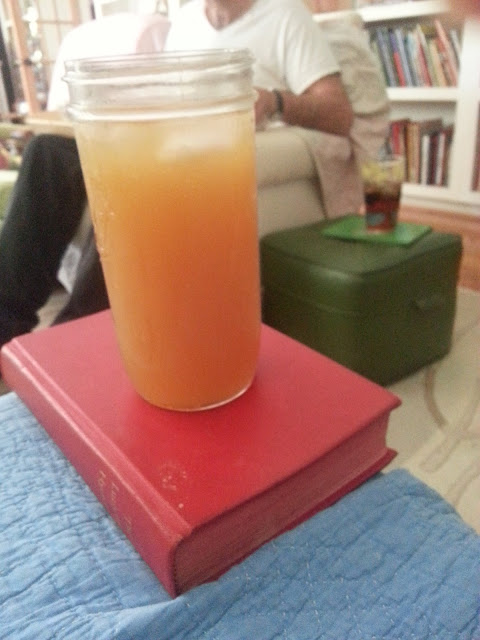 |
| I'm loving apple cider mixed with fizzy water over ice. Jim and I are using our old standby coasters: the back of the old Methodist hymnal for me, and the back of an old Dr. Seuss for him. It works. |
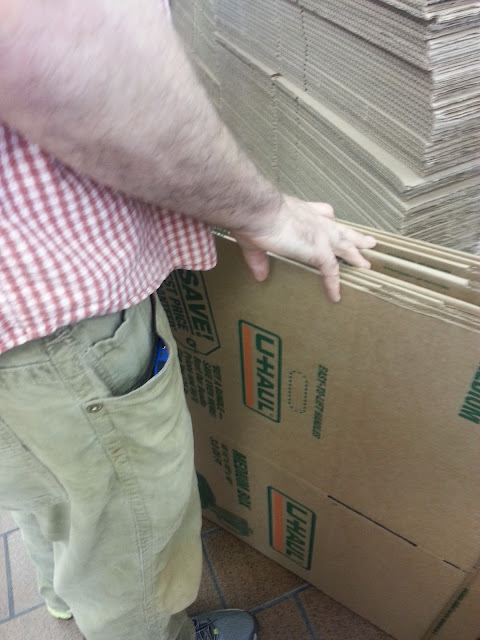 |
| I'd like to think I can go through the entire house with my box system. But I'm trying to stay in the present and hope I can finish the office. That would be a major coup. |
 |
| Saturday breakfast. You should have seen it smothered in almond slices next. Because I could. |
 |
| Our tomatoes are slow to come in. Next year we'll be here in May (so she says) and have more time to get the garden in. I have traveled for 15 years and not had a garden, and I have so missed it. I am determined... |
 |
| Come on! You can do it! Grow, grow... this tomato is on a berm in the back (water management project) along with six or eight others, in an experiment to see if we get enough sun in the back now to grow tomatoes. I think not. The tomatoes in front yard are exponentially bigger. These guys got into the ground at about the same time, the first week in June... we'll see. They are scraggly... grown from seed and too long in their little cups, I fear... |

I’ve talked a lot here about my office space through the years. There was the post about my closet office back in Louisiana and the picture of my research spot in a nearby park. Here in Albuquerque, you’ve seen my office when we first moved in, the addition of my desk, a tour of my bookshelves, the bulletin board above my desk, the rubber rat on the desk itself, and the closet overhaul I had done in May.
While I don’t do the majority of my writing here (I still prefer the couch, the bed, or Starbucks), I love this space. There’s something about being surrounded by familiar books and inspiring words that makes me feel at home.
Last month I added in two more pieces of furniture, a secretary and chair from my parents, who have recently moved to town.

I bought some blue and white knobs and two yards of bird fabric at Hobby Lobby (since a certain sometimes-grubby puppy likes to sit nearby).

The desk as been in front of the window the last year or two, and while I loved being able to look outside, it could get pretty toasty in the summer and rather chilly in the winter. See the little lamp I’ve hooked onto the desk? It’s the one from my office closet days and makes things feel extra cozy in a way the overhead light just can’t.

Here’s a glimpse from the doorway.

And one when standing in front of the window.

Here’s the secretary all prettified.
Sara Zarr in her podcast talks about being “at home in your work”, an idea I really love. Having a welcoming space like this helps me find my way into the writing and all the other tasks that come with the writing life.
How does your work space influence your work?
The post Finding Home in Our Work Spaces appeared first on Caroline Starr Rose.


By:
Heidi MacDonald,
on 6/30/2015
Blog:
PW -The Beat
(
Login to Add to MyJacketFlap)
JacketFlap tags:
News,
Giveaways,
Television,
Comics,
Toys,
Conventions,
Announcements,
Home,
Doctor Who,
Collectibles,
Paul Cornell,
SLG/Slave Labor,
Showbiz,
Paul Pope,
dreamworks animation,
Titan,
Top News,
Assassin's Creed,
Titan Comics,
SDCC '15,
alice x zhang,
Cavan Scott,
Blair Shedd,
heroes reborn,
George Mann,
Des Taylor,
Nicole Phillips,
Roman Dirge,
Scarlett Couture,
Seamus Kevin Fahey,
The Blacklist,
Add a tag
Titan has announced their full line-up of SDCC activities, and there’s lots to choose from with ten signing sessions and two panels, as well as a bunch of exclusive covers, merchandise and sneak-peaks of their upcoming titles.
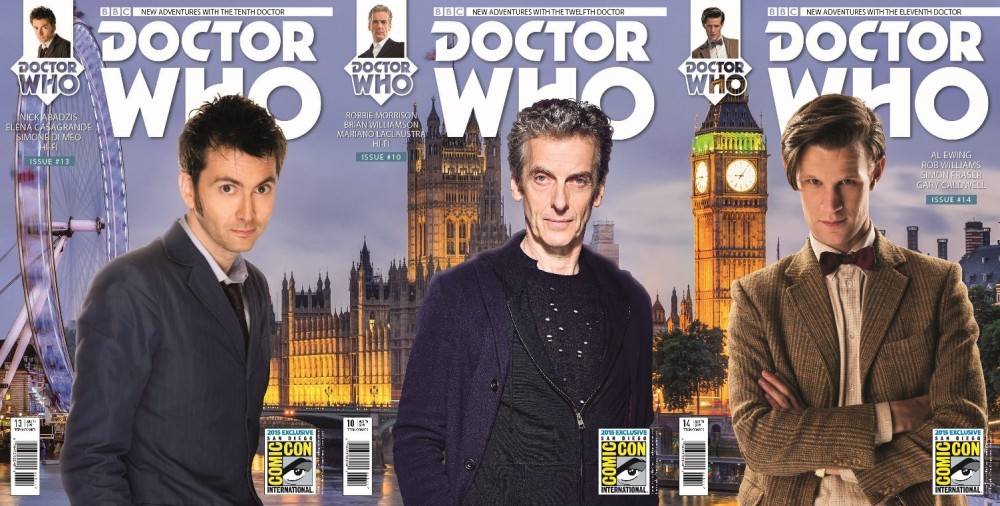
Their Doctor Who line gets it’s own panel this year, where details of a brand new Doctor Who miniseries will be announced, including which of the Time Lord’s many regenerations will star in it. From Titan:
Titan Comics gives you a sneak peek at the next chapters for the Doctor in all his incarnations – including sneak peeks at the direction of Year Two featuring the Tenth, Eleventh and Twelfth Doctors! Writer Cavan Scott and artist Blair Shedd discuss the smash-hit Ninth Doctor mini series! Writer Paul Cornell gives you a sneak peek at August’s comics cross-over event! Writers George Mann and Cavan Scott and cover artist Alice X. Zhang take you behind-the-scenes of the Twelfth Doctor SDCC exclusive short story edition. Plus, we reveal the next brand-new mini series – which Doctor is it going to be? Come along to find out! All attendees receive a FREE Doctor Who comic + prizes to win!
The Titan Doctor Who Comic panel is on Saturday July 11th from 3:30PM-4:30PM in room 5AB.

Fans of Assassin’s Creed can look forward to Titan’s global premiere of artwork from the upcoming comic series based on the hugely popular video game franchise at Titan’s other comics panel on Thursday July 9th from 2:30-3:30PM in Room 4. In addition, the panel features TV producers and writers from Heroes Reborn and The Blacklist who will discuss their work on series tie-in comics. Roman Dirge, creator/writer and artist of the cult-smash series Lenore will also be on hand to talk about his planned new work. From Titan:
Titan Comics takes you behind-the-scenes of major new projects including Assassin’s Creed, Heroes and The Blacklist! See the global premiere of artwork from the new Assassin’s Creed comics, plus be the first to find out about the launch storylines and the all-new Assassins! Heroes Reborn Supervising Producer Seamus Fahey gives you a sneak peek at the new Heroes comic and special SDCC ashcan. The Blacklist TV show writer Nicole Phillips talks about writing the new The Blacklist comic series, which debuts at SDCC! PLUS! The artists of the creator-owned hits of tomorrow will be in attendance! Cult writer Roman Dirge gives you a ghostly glimpse at Lenore and his upcoming new projects! Artist Des Taylor takes you undercover of hit series Scarlett Couture! Harvey award nominated writer Mark Wheatley discusses his new remastered edition of Breathtaker! Plus, more comics talent and prizes to win!
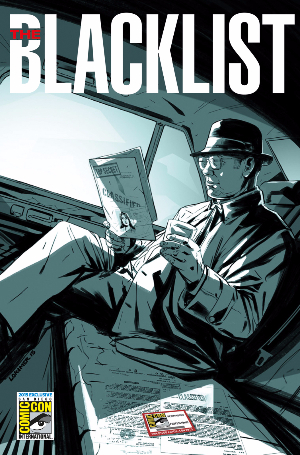
Want to grab an author-signed copy of that gorgeous, SDCC exclusive Heroes ashcan with art from Paul Pope? How about one of only 200 FREE Doctor Who: Four Doctors art cards signed by four Doctor crossover series writer Paul Cornell? Here’s the complete signing schedule, all signings taking place at the Titan booth #5537:
THURSDAY, JULY 9th
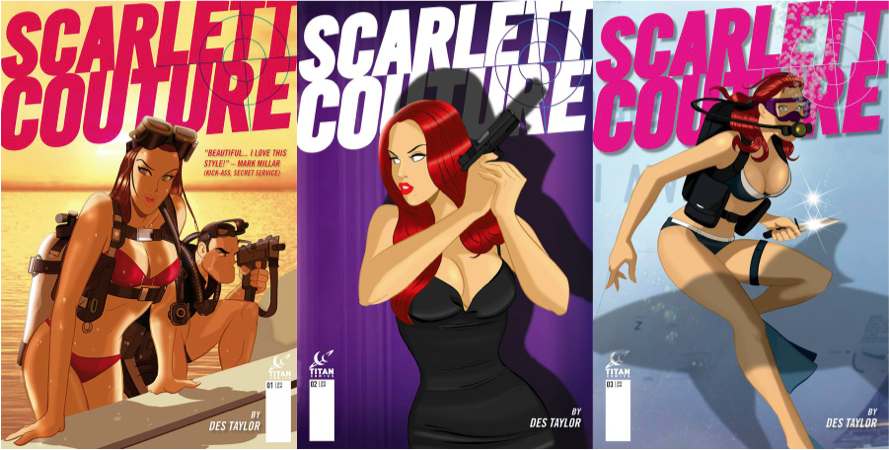
Writer/Artist DES TAYLOR signs copies of Scarlett Couture from 12:30PM – 1:30PM
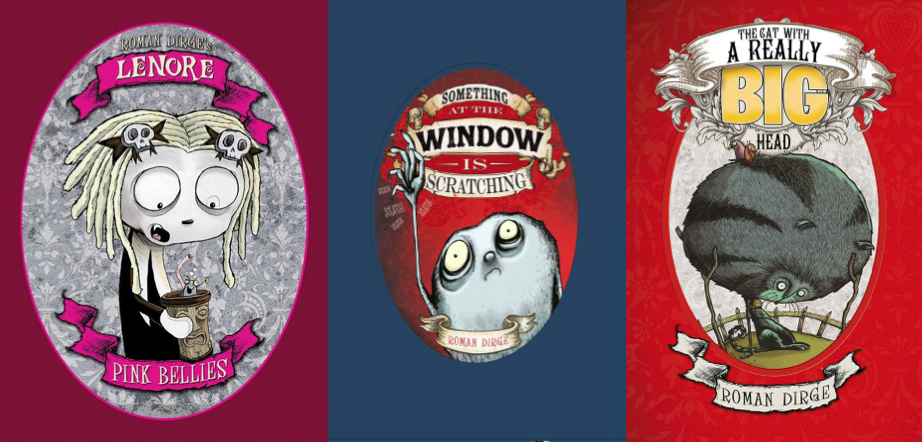
Writer/Artist ROMAN DIRGE will be signing copies of Something at the Window is Scratching, The Cat Really with a Really Big Head and Lenore Pink Bellies: 4:00PM — 5:00PM
FRIDAY, JULY 10th
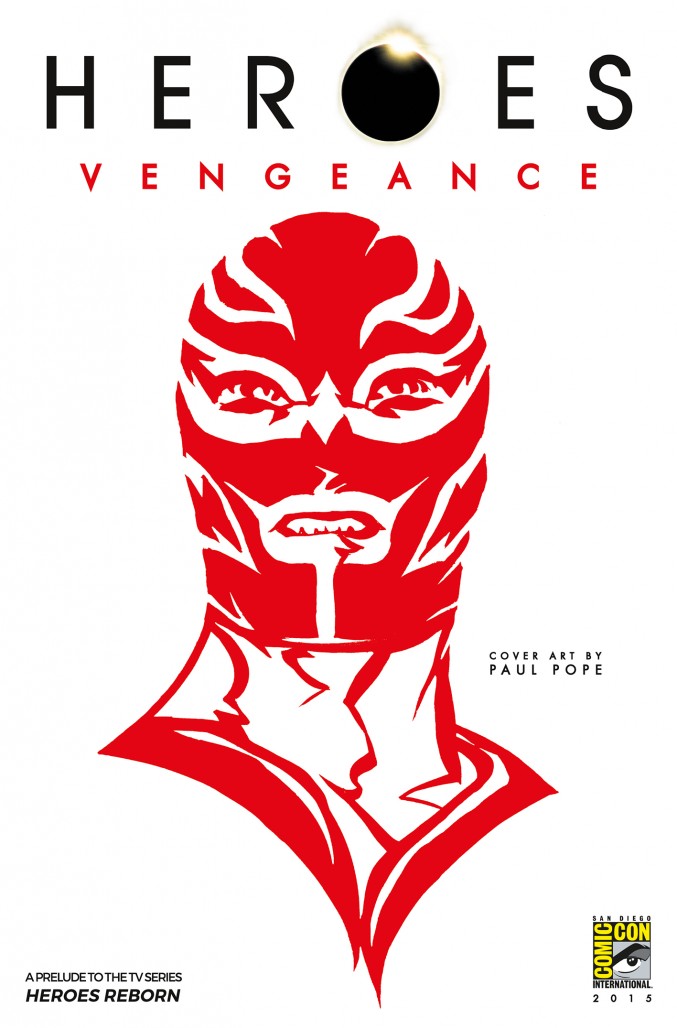
Heroes Reborn Supervising Producer Seamus Kevin Fahey will be signing copies of the Heroes comic SDCC ashcan with exclusive art from Paul Pope from 12:00PM — 1:00PM
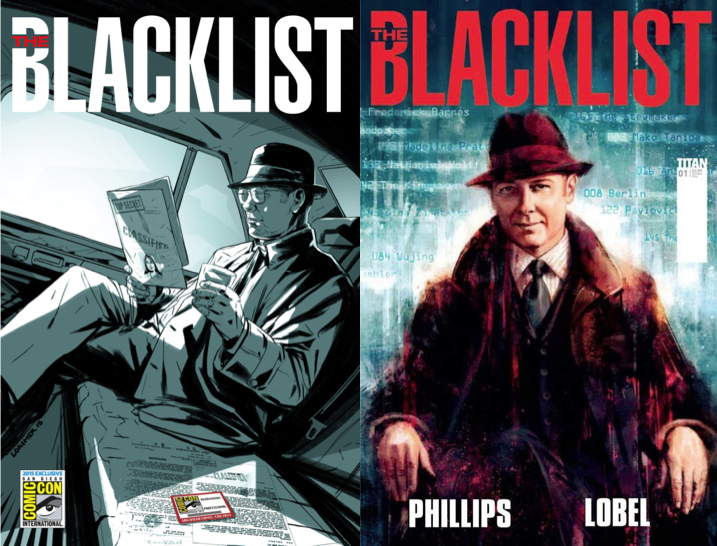
The Blacklist TV show writer Nicole Phillips and cover artist Alice X. Zhang will be signing copies of The Blacklist #1 from Time: 2:00PM – 3:00PM

Writers George Mann and Cavan Scott and cover artist Alice X. Zhang will be signing copies of Doctor Who: Twelfth Doctor SDCC exclusive short story edition from 4:00PM — 5:00PM
Did you miss Roman Dirge’s 7/9 signing? No problem. he’s back at the Titan booth on 7/10 signing copies of Something at the Window is Scratching, The Cat Really with a Really Big Head and Lenore Pink Bellies: 5:30PM – 6:30PM
SATURDAY, JULY 11th
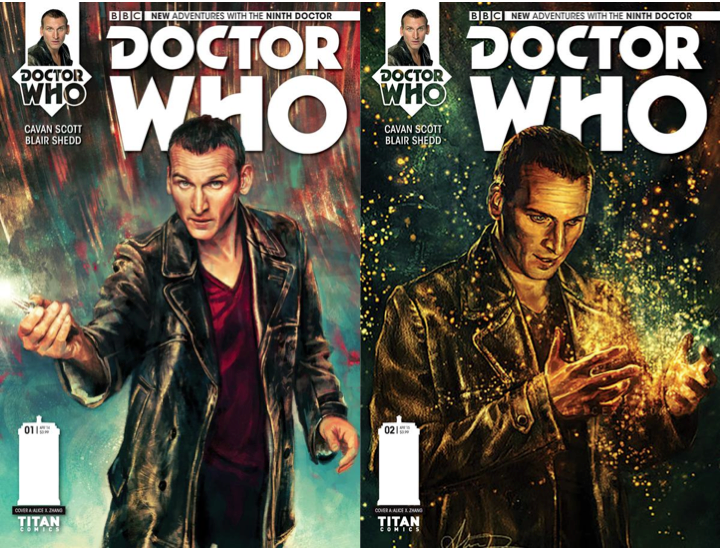
Writer Cavan Scott and artist Blair Shedd will be signing copies of Doctor Who: The Ninth Doctor series from 11:30AM – 12:30PM.
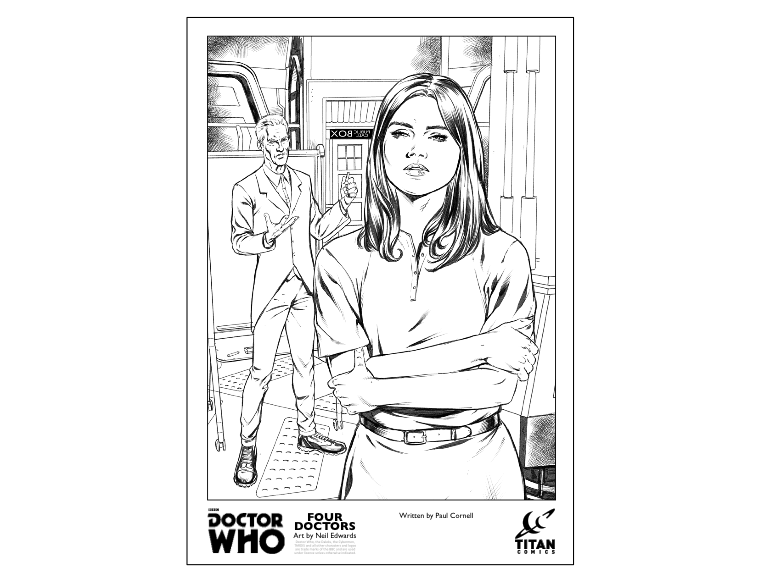
Writer Paul Cornell will be signing a FREE Doctor Who: Four Doctors art card. Only 200 available! From 1:30PM – 2:30PM.
Did you miss Writers George Mann, Cavan Scott and cover artist Alice X. Zhang on 7/10? Fear not, they’re back at the Titan booth signing more copies of Doctor Who: Twelfth Doctor SDCC exclusive short story edition from 5:00PM – 6:00PM.
SUNDAY, JULY 12th

Writer Max Davison, artist Matt Hebb, colourist Tracy Bailey and inker Jason Worthington will be signing copies of DreamWork’s Home #1 comic from 12:00PM – 1:00PM.
Some of you might remember the days I worked in a closet office, a tiny 3′ x 4′ space where I wrote May B. When we moved to New Mexico, I graduated into a full-sized office. Last week the office closet got a little makeover.

Here’s how it all started — a jumbled mess.


Closet insides now on the outside.

Here are my wonderful new shelves from California Closets.

There’s even a special nook for my fake sod brick (doesn’t every author who writes about pioneers have one in her closet?).

Getting organized…

I wrote some words in every single one of these books! Way too fun.

I’m hoping this little fella sends his joy and inspiration over Jasper‘s way.

And here it is! Isn’t it beautiful? I trust nothing will fall on my head the next time I pull back that shower curtain…
The post Office Transformation appeared first on Caroline Starr Rose.

On Being a Late Bloomer is here.
The Year of Exploration is here.
It occurred to me yesterday: I am intuitively doing what I did when I was so young and a single mom, uneducated, needy, and wanting a life for my kids, for myself, wanting to understand the world and to find my place in it. I went to school. I got my undergraduate degree from the many libraries I haunted during those years.
I was barely 22, I was broke, I was alone with two small children, but I had a library card. I still have a library card. Now I have two (
we made peace). Suddenly, in this year of exploration, I am back to school and in much the same way. Let's call it a graduate degree.
I'm following my intuition, pulling on strings when an idea comes to me or someone mentions something that rings a "year of exploration" bell. I am truly following my nose here, as well as my list of
things I want to explore. These notes are the ones I took when listening to Malcolm Gladwell's THE TIPPING POINT from
my library system's Overdrive account. I *love*
Overdrive.And my library.
I don't know what I'll do with what I learn from THE TIPPING POINT, but that's not the point. I know I will use it. I know it's part of the year of exploration. It will tie in with everything else. I've always been a learner; I rarely have a stretch of time in which to learn in depth, intensely. That"s where I am now.
I finally excavated my office. I've been on the road for the past six months -- I've traveled in six months as much as I usually do in a year. I have bought myself some time off the road. My sabbatical starts June 1. I'll still travel. But that travel landscape is going to look different going forward.
More on that later. For now, I've spent the most lovely, rainy Friday afternoon going through ephemera of the past six months on the road. Letters from students, student writing, receipts, little gifts and remembrances, bills and business stuff... "Oh! There's my parking receipt!"... and photographs to remind me of good work done with new friends.
I got on the road 15 years ago when I became so suddenly single, and I've done a good job of taking care of me and mine, I've done good work on the road -- I've learned so much -- and I've written some good books. Now is the time for stillness and learning to love my new hometown, and writing, and learning, and being. Becoming. Something. I don't know what yet. I am trusting the process.
Have a great weekend, friends. I'm going to be off exploring....

Books in the Home, from My Home to Yours
Megan Dowd Lambert [email protected]
Boston Book Fest Hubbub, The Four Seasons, Boston, MA 4/14/2015
Selected Books about Books and Reading
Bottner, Barbara Miss Brooks Loves Books (and I Don’t), illustrated by Michael Emberley
Gerstein, Mordicai A Book
Gravett, Emily Again!
Klausmeier, Jesse Open This Little Book, illustrated by Suzy Lee
Lehman, Barbara The Red Book
Mack, Jeff Look!
Novak, B.J. The Book with No Pictures
Seeger, Laura Vaccaro Dog and Bear: Two Friends, Three Stories
Smith, Lane It’s a Book and It’s a Little Book
Stein, David Ezra Interrupting Chicken
Stewart, Sarah The Library, illustrated by David Small
Willems, Mo Hooray for Amanda & Her Alligator!
Dr. Seuss’s I Can Read with My Eyes Shut!
Willems, Mo We Are in a Book
Scieszka, Jon Summer Reading Is Killing Me, illustrated by Lane Smith
Selected Over- and Under-the-Radar Chapter Books
I’ve Loved Reading Aloud with My Kids
Cleary, Beverly Ramona the Brave
dePaola, Tomie 26 Fairmont Avenue
Gantos, Jack Joey Pigza Swallowed the Key
Gannett, Ruth Stiles My Father’s Dragon
Lai, Thanhha Inside Out and Back Again
Palacio, RJ Wonder
Wilder, Laura Ingalls Little House in the Big Woods
Babbitt, Natalie The Search for Delicious
Cassedy, Sylvia Behind the Attic Wall
Cooper Susan The Magician’s Boy
Jarrell, Randall The Animal Family
LeGuin, Ursula Catwings
Rhodes, Jewell Parker Ninth Ward
Schlitz, Laura Amy The Night Fairy
****
A senior lecturer in children’s literature at Simmons College, Megan Dowd Lambert writes and reviews for Kirkus Reviews and the Horn Book. For nearly ten years she worked in the Education Department of The Eric Carle Museum of Picture Book Art, and in 2015 she published her debut picturebook, A Crow of His Own, illustrated by David Hyde Costello. Her book, Reading Picturebooks with Children: How to Shake Up Storytime and Get Kids Talking about What They See, which introduces her Whole Book Approach storytime method, will be published by Charlesbridge Publishing on November 3, 2015. Megan lives with her family, including six children, in Amherst, MA.

The post Megan Dowd Lambert Hubbub booklist appeared first on The Horn Book.
View Next 25 Posts















 When I saw Welcome to My Neighborhood: A Barrio ABC at the library, I was immediately intrigued. I am always interested in books about people of color and since my daughter is half Latina, I wanted to see what this book was about.
When I saw Welcome to My Neighborhood: A Barrio ABC at the library, I was immediately intrigued. I am always interested in books about people of color and since my daughter is half Latina, I wanted to see what this book was about.

































